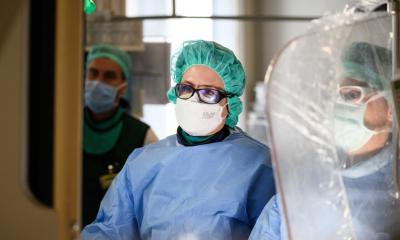News • Study on vascular access options
Intraosseous or intravenous: which way to administer medication during cardiac arrest?
There is no difference in the effectiveness of the two most commonly used methods for administering medication during out-of-hospital cardiac arrest.

Image source: Aarhus University; photo: Lundbeckfonden
There is no difference in the effectiveness of the two most commonly used methods for administering medication during out-of-hospital cardiac arrest. This is shown in a large new clinical study from Aarhus University and Prehospital Services, Region Midtjylland, which compared two ways of accessing the bloodstream: a standard needle in a vein (venous catheter) and a so-called intraosseous needle, which is inserted into the bone marrow.
The results are published in the New England Journal of Medicine.
"When a person suffers cardiac arrest outside the hospital, it is crucial to quickly access the bloodstream to administer life-saving medication. We investigated which method is best," explains Lars Wiuff Andersen, professor and physician at the Department of Clinical Medicine, Aarhus University, Prehospital Services, Region Midtjylland, and Aarhus University Hospital.
Until now, healthcare professionals have preferred using a venous catheter, but it can be difficult to place as veins may collapse during cardiac arrest. The intraosseous needle, inserted either into the shinbone or upper arm, can be faster and easier to use in an emergency. Therefore, it’s interesting to investigate the effectiveness of both methods, explains Lars Wiuff Andersen.

Image source: Aarhus University; photo: Privat
The study, based on data from nearly 1,500 cardiac arrest patients across Denmark, showed that about 30 percent of patients in both groups had their blood circulation restored.
"The two methods proved to be equally effective in restoring blood circulation and saving lives. There was no difference in the patients' survival or quality of life," explains Mikael Fink Vallentin, associate professor at the Department of Clinical Medicine and Prehospital Services, Region Midtjylland, and co-lead author of the study.
According to the researchers behind the study, the results may impact future guidelines, which previously recommended venous catheters as the first choice. However, Lars Wiuff Andersen notes that it is too early to say exactly how the guidelines will change. "Our data must be considered alongside a large clinical trial from the UK, which is being published simultaneously with our study. Combined, these two trials will likely influence guidelines for cardiac arrest treatment, but a thorough review of the results will be needed," he says.
There are still several unanswered questions, especially regarding whether specific groups of cardiac arrest patients benefit more from one method than the other. The researchers are continuing to analyze and compare their own data with data from the UK trial. The Danish research team has already planned a new, large clinical trial to investigate which method is best for delivering electric shocks during cardiac arrest. "We hope to gain even more answers on how to best save lives in cardiac arrest in the future," says Lars Wiuff Andersen.
Source: Aarhus University
04.11.2024











